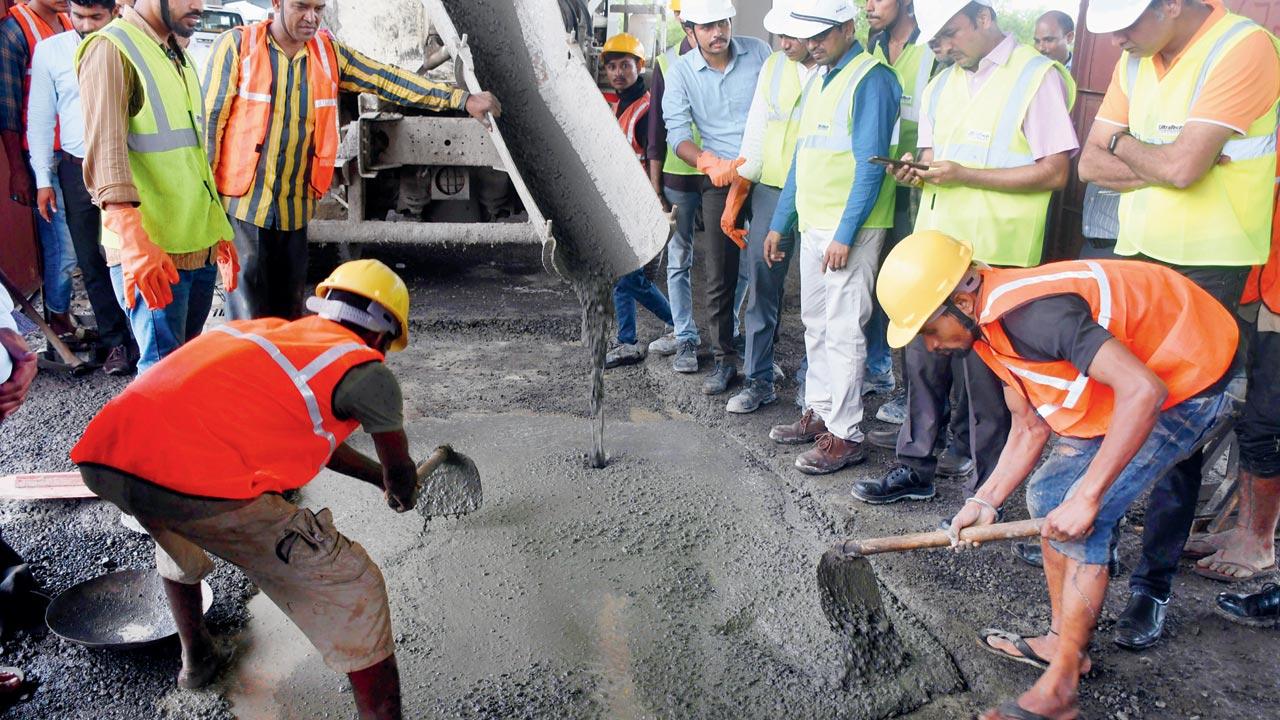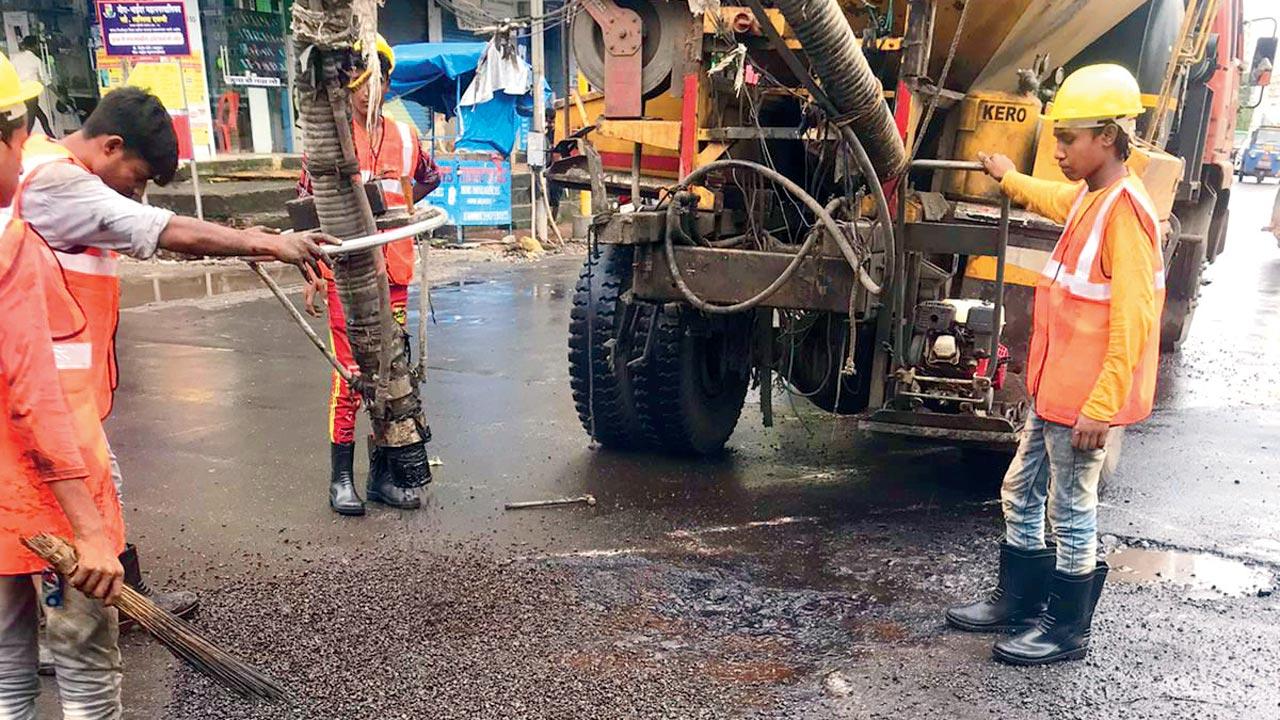As BMC tries out yet another method at Wadala, experts wonder if any lessons have been learnt from civic body’s past failures

Motorists on a nearly impassable stretch of Sant Rohidas Marg, at Dharavi on July 13. Pic/Atul Kamble
Jetpatch, concrete, hot mix and cold mix. These have been among the BMC’s six tools to seal potholes on Mumbai’s roads over the past 12 years, but all have failed to give citizens relief from bumpy and risky rides during the monsoon. As part of its search to find a solution to the city’s pothole problems, the civic body has turned to geopolymer, rapid hardening concrete and M600 concrete this time.
ADVERTISEMENT
The BMC first used the JetPatch machine during 2010-11. While it bought three machines for Rs 78 lakh each, the technology was used for a while and a year later, the machines lay unused. Today, no one at the civic body knows where the machines are. “The machine had a limitation as it could fill a small pothole. Also, the machine was huge so it could not be operated on internal narrow roads,” said a corporation official.
Also read: Mumbai: Roads will be pothole-free in 2 years, says BMC

A pothole being sealed with rapid hardening concrete, near Dayshankar Chowk on July 22. Pic/Ashish Raje
The machines were supposed to repair potholes within hours where conventional pothole repairs would take 48 hours. The BMC spent R68 crore on the repair and maintenance of the machine, but despite that engineers were unable to use them due to technical glitches. Procured from the US, the machines could repair stretches of about 80-100 sq m in a day, but after that, it became difficult to refill it with the repair mix and use it again the same day. Also, the machine was rendered useless for potholes smaller than 2×2 feet and on wet roads. The BMC was reportedly in talks with the manufacturers for modifications.
Mixture from Austria, Israel
In 2015-16, the civic body used an Austrian and Israeli mixture for instant repairs. “But the experiment did not last long as the material was 10 times costlier than the traditional cold mix and also there was no good result,” said the official.
The poor condition of city roads had prompted the HC to take up a suo motu public interest litigation after which the HC directed the BMC to consult experts from the IIT and the Central Road Research Institute to ensure better-quality material is used to repair potholes. The BMC then purchased material from Eco Green Infrastructure Development in Austria and Smart Age Products in Israel for Rs 70 lakh.

A JetPatch machine being used. File pic
Hot and cold mix
“The BMC uses hot mix and cold mix. However, only cold mix is used regularly. We are using hot mix if there is a long dry spell,” said Ulhas Mahale, deputy municipal commissioner.
In hot mix, a mixture of asphalt and gravel is used for road repair at temperatures above 300 degrees Celsius. The BMC had its own hot mix plant at Worli, which originally produced around 11,000 tonnes of hot mix to fill potholes every year. Most of this filling is produced and used in the monsoon season. However, the civic body found that the hot mix failed to fix potholes in the rainy season. So, they had to fix the same pothole five to six times in a row. The plant later drastically limited the production of hot mix after finding other options.
Cold mix, in comparison with hot mix, required only 10 per cent compression and it easily settled in watery areas. Hardly 10 per cent of the manufactured cold mix was used to solve the issue. The first few years were good, but rain and heavy traffic washed away these dreams too.
The new trio
Source said Additional Municipal Commissioner P Velrasu has directed officials to explore new technologies. “We recently tried geopolymer, rapid hardening concrete and M600 concrete to repair 3 potholes on Wadala Anik road. This is a heavy traffic road. We will examine these materials for 2 months. Then we will decide whether to use this method or not for next year,” said Mahale. Geopolymer mix is a combination of sand, stone and polymer. After using this, a road can be opened to traffic within two hours.
Rapid hardening was recently tried below a road on the eastern freeway. But the patch needed to be barricaded for six hours afterwards before the road was reopened to the public.
M-60 concrete fixes the pothole, but the road needs to be kept shut for six days. BMC officials will need to put a steel plate to cover the area and keep the traffic moving as the M-60 settles down and dries up.
The other idea is to simply fill it up with paver blocks and level up the road. Civic official said they put paver blocks as a temporary solution on some stretches during heavy rain.
‘Focus on quality first’
“This is the story of Mumbai roads every year. The BMC doesn’t follow Indian Road Congress guidelines for repairing roads,” said activist Godfrey Pimenta. “The reason given is that there are potholes on the roads because it rains a lot in the city. But even though it rains a lot in Vietnam there are no potholes on the roads,” Pimenta said, “If road repairs are done properly there will be no problem with potholes. But BMC doesn’t want to look at the root cause of potholes.”
Activist Nikhil Desai was equally unsparing in his criticism. “It is a gimmick every year to find a new technology to repair the potholes. The quality of the road should be maintained while it is being made. After the road is made, trenches are dug on it after a few months which harm the quality of the roads. BMC should plan properly,” he said.
Citizen activist Sanjay Gurav said, “Then what happens in Mumbai. The roads in some parts of Mumbai are of good quality. Then why are there not such roads in the entire city?”
D D Naik, former BMC Road Department engineer, said, “Excavation is rampant on asphalt roads. It damages the road surface as well as the foundation and the quality of the roads deteriorates. BMC should work on a duct policy.”
12,000
No. of potholes in city between April and July 15
 Subscribe today by clicking the link and stay updated with the latest news!" Click here!
Subscribe today by clicking the link and stay updated with the latest news!" Click here!







